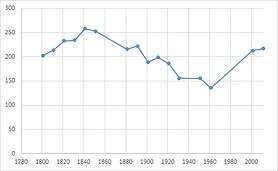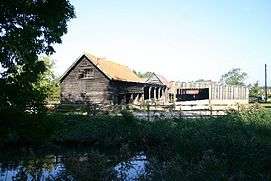St Cross, South Elmham
| St Cross, South Elmham | |
 The Church of St George, located in St Cross, South Elmham |
|
 St Cross, South Elmham |
|
| Population | 217 (2011)[1] |
|---|---|
| District | Waveney |
| Shire county | Suffolk |
| Region | East |
| Country | England |
| Sovereign state | United Kingdom |
| Post town | Beccles |
| Postcode district | IP20 0 |
| Police | Suffolk |
| Fire | Suffolk |
| Ambulance | East of England |
| EU Parliament | East of England |
Coordinates: 52°24′18″N 1°22′34″E / 52.405°N 1.376°E
St Cross, South Elmham is a village and civil parish in the Waveney district of Suffolk in eastern England. One of the Saints, in 2010 its population was 120, increasing to 217 at the 2011 census. The population has an average age of 43 and is evenly split between genders, with 106 males and 111 females.[2] The village name is a portmanteau of the medieval parish name "Saint George Sancroft", as the village church is named St George.[3] The Sancroft part of the name comes from the sandy nature of the soil the area surrounding the church of St George.[4]
The village itself is small in size and lacks many traditional features such as a village pub or shop, instead only containing a number of cottages and farms including Greshaw Farm, Weston House Farm and South Elmham Hall Farm.[5] A volunteer group known as Waveney Community Bus, provide a bus service to residents living in the St Cross area.[6] St Cross is known for its picturesque views of the English countryside and was home to the poet and writer Elizabeth Smart (Canadian author) for the last years of her life. She was buried in the graveyard of the church of St George after her death in 1986.[3]
In 1870–72, St Cross, South Elmham was described by John Marius Wilson's Imperial Gazetteer of England and Wales as
"St. Cross, or Sandcroft, a parish in Wangford district, Suffolk; adjacent to the river Waveney, and to the Waveney Valley railway, near Homersfield r. station, 5 miles SW of Bungay. The church is tolerable. Some remains exist of a moated minster, with nave 42 feet by 27, and apsidal chancel 24 feet."[7]
In 1868 The National Gazetteer of Great Britain and Ireland described St Cross as
"South Elmham St.Cross, (or Sandcroft), a parish in the hundred of Wangford, county Suffolk, as above, 5 miles S.W. of Bungay, and 4 N.E. of Harleston, its post town. There was formerly a monastic establishment here, the remains of which are surrounded by a moat. The living is a rectory annexed to that of Homersfield, in the diocese of Norwich. The church is a neatly built edifice with square embattled tower, and Norman arch at the S. entrance. St. Margaret's Hall is the principal residence. Sir R. Adair is lord of the manor."[8]
The population of St Cross from 1800–2011 can be seen on the graph below. The population climbed rapidly until the 1840s, where it started to increasingly decline each decade. This could be attributed to the industrial revolution occurring at the time, which would have potentially drawn residents away to work in cities or in emerging industries. The population starts to increase steadily after the 1960s eventually rising to 1800 levels in 2001. The rise in population could be attributed to the areas idyllic landscapes which attracts older and wealthier residents to retire in the area.

History
St Cross was created as a result of the merger with the lands around Homersfield in 1767. Before this it was part of the lands owned by the See of Norwich until the reign of King Henry VIII, its revenues distributed to the Church.[4] With the dissolution of the monasteries in 1540 the land was transferred back to the crown.[9] The manor and its surrounding lands were eventually given to the North family in the 17th century valued at £20.[4] After the Norths, the manor and its lands were transferred to the Tasburgh family.[4] Eventually ownership was taken over by the Durrant family in the 19th century.[4] It is unknown who owned the land of St Cross from the 17th–19th century before the Durrant family took ownership.
Economy

The main employment industries in the area are the retail and agricultural trades, which each employ 16% of the population, with health and social work and education taking up another 12% and 10% respectively.[10] Occupational data from 1881, shows that the majority of the population worked in agriculture a trend that continues to this day, with the rest of the male occupations spread out between mining, hospitality and professional services.[11] The majority of the female occupations are listed as unknown or unspecified, probably due to many of them being stay at home wives or working on the farms alongside their husbands, as was common for the time. The few who were employed full-time worked in domestic services, probably employed by the nearby manor house, which would require a domestic staff to keep it running successfully.
Places of Interest

South Elmham Hall
The parish contains South Elmham Hall, surrounded by a four-acre moat and which was formerly the country residence of the Bishop of Norwich.[3] The hall is currently known as Bateman's Barn and offers guided historic tours of the house and its grounds during the summer months.[12] South Elmham Hall has been listed as a grade one building.[13] The building contains primarily 16th century architecture, alongside 15th century arches constructed during the Bishops ownership of South Elmham Hall.[5] The primary attraction of the South Elmham area to the Bishops was the hunting opportunities provided by a deer park established in the local area.[9] This was not without problems with reports of the deer being poached by the residents of St Cross in 1315. The Hall also hosted royal family members on several occasions, most notably in 1326 when Edward II stayed for ten days on his way to Norwich, carrying out government business during his stay there.[9] The remains of previous buildings and settlements nearby to the hall have long since decayed, although around 45 detailed surviving records in the Suffolk Record Office indicate the area used to contain stables, mews and gatehouses.[9] The ruins of one of the gatehouses survives and can be still be seen today. South Elmham Hall also has the earliest domestic wall paintings in Suffolk, dating from 1270.[9]
The Church of St George
The village contains the church of St George first constructed around a century before the Norman conquest of Britain, though many modifications and added developments were made in the centuries afterwards, such as the addition of the square bell tower in the 14th century.[3] The church is the largest of the churches in the Saints area and has been through several renewals over its history, to restore and renovate areas including the floor, which was replaced with Victorian styled tiles in the 19th century and the benches, which were replaced when the previous ones started to decay. St George's is now open to the public on a daily basis after previously being kept locked for a number of years.[3]
South Elmham Minster
Nearby to South Elmham Hall lies the remains of a site known as South Elmham Minster. The remains date from Roman times, before the Norman conquest of Britain and the building is believed to have been the private chapel of the Bishop of Norwich during his residence at South Elmham Hall.[14] The chapel was built on the remains of a Roman temple that had previously been located there.[14] The exact reasons behind the chapel's disuse and abandonment are unknown, as it fell out of use in the sometime in the 13th century.
References
- ↑ "Civil Parish population 2011". Retrieved 20 September 2015.
- ↑ Council, Waveney District. "Waveney District Council download – Village and town profiles 2014 | Business | Planning | Local development framework". www.waveney.gov.uk. Retrieved 20 February 2016.
- 1 2 3 4 5 Knott, Simon (July 2008). "St George, South Elmham, St Cross". www.suffolkchurches.co.uk. Retrieved 2016-03-18.
- 1 2 3 4 5 Suckling, Alfred (1864). "South Elmham, St George or St Cross". British History Online. WS Crowell. Retrieved 2016-03-18.
- 1 2 Baxter, Ron (21 March 2016). "St George, South Elmham St Cross, Suffolk". The Corpus of Romanesque Sculpture in Britain & Ireland. The Corpus of Romanesque Sculpture in Britain & Ireland. Retrieved 2016-03-21.
- ↑ McClellan, Christine (1 September 2009). "Waveney Community Bus Limited" (PDF). Waveney Community Bus Limited. Retrieved 2016-03-23.
- ↑ Wilson, John Marius (1870–72). Imperial Gazetteer of England and Wales. Edinburgh: A. Fullerton & Co.
- ↑ Hamilton, N. E. S. A (1868). The National Gazetteer of Great Britain and Ireland (1868). London: Virtue. ISBN 978-1861508782.
- 1 2 3 4 5 Sanderson, John (22 March 2016). "History of the Hall". Bateman's Barn.
- ↑ Council, Waveney District. "Waveney District Council download – Village and town profiles 2014 | Business | Planning | Local development framework". www.waveney.gov.uk. Retrieved 20 February 2016.
- ↑ "South Elmham St Cross through time. Industry Statistics and Occupation data classified into the 24 1881 orders, plus sex". www.visionofbritain.org.uk. Retrieved 2016-03-21.
- ↑ "Historic Venue, Conference and Wedding Facility at South Elmham Hall, Suffolk". www.batemansbarn.co.uk. Retrieved 20 February 2016.
- ↑ England, Historic. "SOUTH ELMHAM HALL – 1031966 | Historic England". historicengland.org.uk. Retrieved 20 February 2016.
- 1 2 Knott, Simon (22 March 2016). "South Elmham Minster, South Elmham St Cross". Suffolk Churches. Retrieved 2016-03-22.